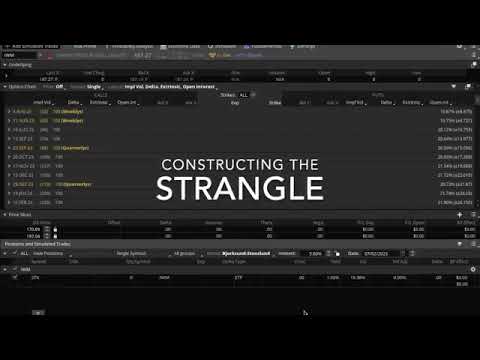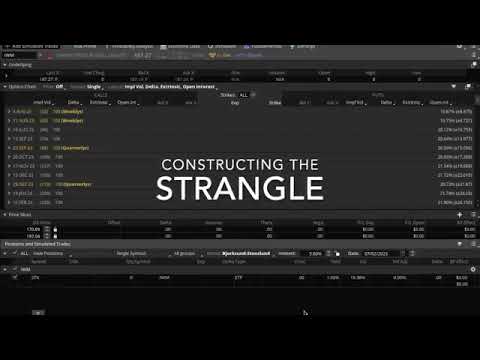Let’s dive into the world of options trading with the video “3-7 Constructing The Strangle” by Heating & Cooling Solutions. In this video, you’ll learn how to construct a strangle options strategy, which is easier compared to the iron condor strategy. With only two strikes, a short put and a short call, it’s a simpler approach. The video takes you through the process step by step, starting with finding the optimal Delta strike price and adjusting it accordingly. You’ll also explore the risk profile and understand the benefits of trading the strangle strategy over the iron condor. So, whether you’re new to options trading or looking to expand your knowledge, this video will provide valuable insights and help you construct effective strangles for your trading endeavors.
Constructing The Strangle

Introduction to constructing the Strangle
When it comes to constructing options trading strategies, the Strangle stands out for its simplicity and effectiveness. Unlike the Iron Condor strategy, the Strangle strategy only requires two strikes – a short put and a short call. This makes it much easier to construct and execute. In this article, we will explore the process of constructing the Strangle strategy, its benefits, and how it compares to other strategies.
Comparison to the Iron Condor strategy
Compared to the Iron Condor strategy, the Strangle strategy is relatively simpler. The Iron Condor strategy requires four strikes – a short put spread and a short call spread. This makes it more complex and increases the number of potential adjustments that need to be made. In contrast, the Strangle strategy only requires two strikes, making it easier to manage.
Choosing the strike prices
When constructing a Strangle strategy, it is important to carefully choose the strike prices. The optimal Days to Expiration (DTE) can vary depending on market conditions and personal preferences. Once you have determined the optimal DTE, you can start identifying the 16 to 20 Delta strike prices. These strike prices are usually considered ideal for a Strangle strategy. For example, if the 16 Delta strike price for a particular stock is $175, you can right-click on it, analyze the sell trade, and choose the Strangle option. This will give you half of the Strangle spread.
Analyzing the risk profile
After choosing the strike prices, it is important to analyze the risk profile of the Strangle strategy. The Profit and Loss (P&L) graph provides a visual representation of the potential profit and loss at different price levels. By analyzing the risk profile, you can determine the win rate and understand how wide the range of potential profits and losses is. The wider the range, the more favorable the risk profile.
Benefits of trading the Strangle
Trading the Strangle strategy offers several benefits. One of the key benefits is the potential for consistent profits. Compared to the Iron Condor strategy, the Strangle strategy tends to yield more consistent profits. This has been observed in personal experience and the results of many traders. Additionally, trading the Strangle strategy requires fewer funds compared to the Iron Condor strategy, making it more accessible to traders with limited capital.
Constructing the bullish Strangle
To construct a bullish Strangle, it is important to choose the right Delta levels for both the put and call sides. For the put side, a higher Delta is preferred, while for the call side, a lower Delta is desired. This will shift the Strangle towards the upper side, indicating a bullish sentiment. Additionally, considering different Delta levels allows for customization based on personal preferences and the desired level of bullishness.
Choosing the Delta for the put side
For a bullish Strangle, it is recommended to choose a Delta around 25. This Delta level indicates a higher probability of the put option expiring in the money, aligning with a bullish sentiment. To determine the suitable strike price, you can refer to the available options chain and identify the 25 Delta strike. For example, if the 25 Delta strike is priced at $180, it can be chosen as the put strike for the Strangle strategy.
Choosing the Delta for the call side
For the call side of a bullish Strangle, it is generally recommended to choose a Delta lower than the put side Delta. This helps balance the positioning of the strategy and maintain a bullish bias. By referring to the options chain, you can identify the desired Delta level for the call side. For example, if the 10 Delta strike is priced at $203, it can be chosen as the call strike for the Strangle strategy.
Considerations for the premium drop
When selecting the Delta levels for the Strangle strategy, it is important to consider the potential premium drop. If you choose a Delta that is too far out, the premium may decrease significantly, making the call option less valuable. It is essential to evaluate whether it is worth including the call option based on the potential premium drop and the overall premium of the strategy.
Putting on the bullish Strangle
After choosing the appropriate strike prices and Delta levels, the bullish Strangle can be put on. By executing the short put and short call options at the selected strike prices, the Strangle strategy is implemented. It is important to review the price lines at the breakeven point to assess the potential profit and loss.
Analyzing the win rate for the bullish Strangle
Analyzing the win rate of the bullish Strangle provides insight into the strategy’s effectiveness. While the win rate may experience a slight decrease compared to the theoretical win rate, it is still expected to be relatively high. The wider range of potential profits and losses offered by the Strangle strategy contributes to its appeal and the potential for consistent profits.
Getting more bullish and adjusting the strikes
As market conditions change and your outlook becomes more bullish, you may consider adjusting the strikes to reflect your increased bullish sentiment. This can involve shifting the put strike closer to the market, such as from $180 to $184. Additionally, you can choose to either keep the call strike as it is or shift it further out, depending on your preferences and analysis of the potential premium drop.
Constructing the bearish Strangle
The construction of the bearish Strangle is similar to that of the bullish Strangle, but with the opposite sentiment. For the call side of the bearish Strangle, a Delta of around 25 is preferred. By referring to the options chain, you can identify the suitable strike price based on the selected Delta. Similarly, for the put side, a Delta lower than the call side Delta is recommended. By choosing the appropriate Delta and strike price, the bearish Strangle can be constructed.
Putting on the bearish Strangle
Once the Delta levels and strike prices have been chosen for the bearish Strangle, the strategy can be executed by selling the short call and short put options at the selected strikes. This completes the construction of the bearish Strangle and the strategy is ready to be implemented.
Conclusion
Constructing the Strangle strategy involves choosing the optimal Delta levels, strike prices, and analyzing the risk profile. The Strangle strategy offers several advantages, including consistent profits and simplicity compared to other strategies like the Iron Condor. By understanding the construction process and considering personal preferences and market conditions, traders can effectively utilize the Strangle strategy in their options trading journey.
